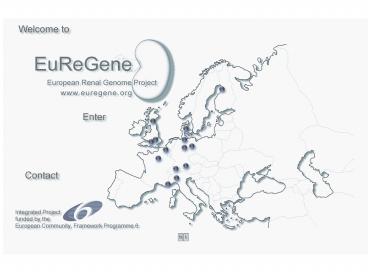Integrated Project of EC Framework program 6 - PowerPoint PPT Presentation
1 / 16
Title:
Integrated Project of EC Framework program 6
Description:
adult mouse kidney, and Xenopus pronephros. Topic 1: Technology development ... Xenopus: A. Br ndli, ETH Zurich. Topic 3: Pathophysiology ... – PowerPoint PPT presentation
Number of Views:36
Avg rating:3.0/5.0
Title: Integrated Project of EC Framework program 6
1
(No Transcript)
2
EuReGene
- Integrated Project of EC Framework program 6
- Project period 2005 to 2008
- Coordinating Center Max-Delbrueck-Center
- for Molecular Medicine
- Berlin, Germany
- Participating Centers
- - INSERM (Paris, Nice) - Biocenter Oulu
- - MRC (Edinburgh, Harwell) - University
Hamburg - - UCL Med School Brussels - University
Aarhus - - ETH Zurich - University
Oxford - - University Zurich -
University Munich - - Mario Negri Inst. Bergamo - ReceptIcon ApS
- - Max-Planck-Institute Hannover
3
Partners
Germany Friedrich Luft, Berlin Dominik Müller,
Berlin Thomas Willnow, Berlin Thomas Jentsch,
Hamburg Gregor Eichele, Hannover Matthias
Kretzler, Munich UK Nick Hastie, Edinburgh Jamie
Davies, Edinburgh Duncan Davidson,
Edinburgh Roger Cox, Harwell Raj Thakker,
Oxford France Corinne Antignac, Paris Andreas
Schedl, Nice Pierre Verroust, Paris
Switzerland Andre Brändli, Zurich Heini Murer,
Zurich Carsten Wagner Belgium Olivier Devuyst,
Brussels Pierre Courtoy, Brussels Italy Guiseppe
Remuzzi, Bergamo Finland Seppo Vanio,
Oulu Denmark Eric Ilsoe Christensen,
Aarhus Anders Nykjaer, Aarhus
4
Goals
Call 1.1.1.a) Multidisciplinary functional
genomics approaches to basic biological
processes to characterize major genetics
pathways involved in development, physiology
and pathophysiology of the kidney ( Renal
Genome) to describe identified renal gene
interactions in a 3D kidney atlas
5
Why the kidney?
- Socio-economic impact of renal diseases
- 4.5 Mio Europeans affected from renal diseases
- European health care expenses 10 billion
annually - 225,000 require renal replacement therapy
- shortage in organ donor supply
- 20 annual death rate in patients
- with ESRF
6
Why the kidney?
- Model organ
- prototype tissue for organ atlas project
- well-defined tissue architecture closely
- aligns with biochemical function
7
Why an organ atlas?
Renal diseases multifactorial, complex
genetic processes common, but complicated
to study
Forwards Genetics
Renal genes monogenic factors of (patho)-
physiological processes more easy to analyze,
but rare events
Reverse Genetics
8
Why an organ atlas?
Kidney atlas 3D reconstruction of renal
tissue architecture spatial and temporal
relation- ship of major renal genes
Renal genes characterize master gene
pathways of renal development and disease in
animal models
Bioinformatic tools
9
Model systems
use of transgenic animal models apply
specific gene targeting, knockdown, and random
mutagenesis to develop now models of renal
development and disease describe consequences
of altered gene function implementation data in
kidney atlas Models
Zebrafish Xenopus laevis Mouse
Rat - E17.5 and 12 wks - male
C57BL/6J
10
Areas of Research
Topic 1 Technology development Topic
2 Renal development Topic 3 Pathophysiology
Topic 4 Complex genetics
11
Topic 1 Technology development
3D reconstruction of kidney architecture D.
Davidson, MRC Edinburgh Adapt optical
projection tomography for renal tissue
specimens provides conceptual framework to
model all data reconstruction of the mouse
E17.5 and adult mouse kidney, and Xenopus
pronephros
12
Topic 1 Technology development
Renal gene expression maps G. Eichele, MPI
Hannover Develop gene paint technology for
automated high-throughput gene expression
profiling on the embryonic (E17.5) and adult
mouse kidney
13
Topic 2 Renal development
- Renal gene expression profiles
- High throughput ISH A. Brändli, ETH Zurich
- G. Eichele, MPI Hannover
- Microarrays A. Brändli, ETH Zurich
- Nephrogenesis in model lines
- Mouse A. Schedl, INSERM Nice
- S. Vainio, Biocenter Oulu
- Zebrafish N. Hastie, MRC Edinburgh
- Xenopus A. Brändli, ETH Zurich
14
Topic 3 Pathophysiology
Characterization of transgenic animal models of
renal dysfunction Pathophysiological markers
and renal expression maps Physiology Ion
transport T. Jentsch (Cl channels) D.
Müller (claudins, paracellular ion
transport) T. Willnow (sodium
co-transporter) Acid-base, phosphate
transport H. Murer, C. Wagner (NaPi-IIa)
Protein transport E.I. Christensen (endocytic
receptors) O. Devuyst (endocytic
receptors) Pathology Glomerulosclerosis S.
Vainio (Wnt11) A. Schedl (Pax2) C.
Antignac (podocin) Inflammation F. Luft
(hypertension-induced, vascualitis)
Nephrotoxicity ReceptIcon ApS (drug-induced
nephrotoxicity)
15
Topic 4 Complex genetics
- Identification of novel genes in renal
pathophysiology - Map modifiers in established models of disease
- Proteinuric kidney damage G. Remuzzi,
Bergamo - Diabetic nephropathy R. Cox, Harwell
- Renal stone disease R. Thakker, Oxford
- Glomerulosclerosis C. Antignac, INSERM
Paris - Identify new genes in random mutagenesis screens
- ENU mouse screen R. Cox, Harwell
16
The Kidney Atlas Project
histological section, annotation of structure
annotation of function, link to data bases
3D image reconstruction
add. Information, links































